Trogons
| Trogons | ||||||||||||
|---|---|---|---|---|---|---|---|---|---|---|---|---|

Sumatran Trogon ( Apalharpactes mackloti ) |
||||||||||||
| Systematics | ||||||||||||
|
||||||||||||
| Scientific name of the order | ||||||||||||
| Trogoniformes | ||||||||||||
| AOU , 1886 | ||||||||||||
| Scientific name of the family | ||||||||||||
| Trogonidae | ||||||||||||
| Lesson , 1828 |
The trogons (Trogonidae), also called gnaws , are the only recent family in the order of the Trogoniformes. There are six genera and 39 species in this family. They inhabit the tropical forest areas in Africa , India , Southeast Asia and Central and South America and spend most of the day in trees. They are seldom on the ground. With their short, weak legs, they are not good runners. Some species of the trogons are endangered by the destruction of their habitat, for example the quetzal , the national bird of Guatemala .
features
Trogons are among the most colorful of birds. However, they can hardly be seen in the trees. Especially the males show themselves in a splendid dress, the females are less conspicuously colored. The feathers sit very loosely in the thin, easily torn skin. The plumage on the upper side usually has a luminous, metallic shimmering, emerald green, green or blue color, occasionally also brown. On the underside, the plumage is often red, blue, yellow, or white. They have rounded wings and long tail feathers. On their climbing feet, two toes point forward and two point backward. In contrast to other tree-dwelling birds, in which the first and fourth toes point backwards (so-called zygodactyl feet), in the trogons the first and the second point backwards (so-called heterodactyl feet). This position of the toes earned them the nickname "reverse pelvic" and is a special adaptation to life in the trees. They feed on insects, other invertebrates, berries and fruits. On their short, broad and powerful beaks, on each side of the beak root, there are stiff bristles that form a kind of fishing gear for flying prey.
Reproduction
Trogons are cave breeders. With the beak and the feet a cave is dug in a rotten tree or in a termite mound or they occupy an abandoned nesting hole. The clutch, which consists of two to four eggs, is hatched by both adult birds. Depending on the species, the eggs are white, greenish, bluish or yellowish in color. Both parent birds participate in the rearing.
Genera and species
-
Apaloderma
- Bergtrogon ( Apaloderma vittatum )
- Yellow-cheeked trogon ( Apaloderma aequatoriale )
- Narinatrogon ( Apaloderma narina )
-
Apalharpactes
- Sumatran Trogon ( Apalharpactes mackloti )
- Reinwardttrogon ( Apalharpactes reinwardtii )
-
Euptilotis
- Haarbüscheltrogon ( Euptilotis neoxenus )
-
Harpactes
- Diardtrogon ( Harpactes diardii )
- Gray-breasted trogon ( Harpactes whiteheadi )
- Malabartrogon ( Harpactes fasciatus )
- Orangebrusttrogon ( Harpactes oreskios )
- Philippinentrogon ( Harpactes ardens )
- Rose- tailed trogon ( Harpactes wardi )
- Red-rumped Trogon ( Harpactes duvaucelii )
- Red- headed Trogon ( Harpactes erythrocephalus )
- Red-necked Trogon ( Harpactes kasumba )
- Cinnamon Trogon ( Harpactes orrhophaeus )
-
Pharomachrus
- Gloss trogon ( Pharomachrus fulgidus )
- Goldkopftrogon ( Pharomachrus auriceps )
- Combed Trogon ( Pharomachrus antisianus )
- Peacock Trogon ( Pharomachrus pavoninus )
- Quetzal ( Pharomachrus mocinno )
-
Priotelus
- Kubatrogon ( Priotelus temnurus )
- Rosentrogon ( Priotelus roseigaster )
-
Trogon
- Bairdtrogon ( Trogon bairdii )
- Blue- headed Trogon ( Trogon curucui )
- Bronze trogon ( Trogon mexicanus )
- Gold-bellied Trogon ( Trogon aurantiiventris )
- Gray-headed Trogon ( Trogon citreolus )
- Maiden Trogon ( Trogon collaris )
- Copper Trogon ( Trogon elegans )
- Masked Trogon ( Trogon personatus )
- Slate- tailed trogon ( Trogon massena )
- Black throated trogon ( Trogon rufus )
- Black- headed Trogon ( Trogon melanocephalus )
- Schwarzschwanztrogon ( Trogon melanurus )
- Sparrow- tailed trogon ( Trogon clathratus )
- Surucuatrogon ( Trogon surrucura )
- Violet Trogon ( Trogon violaceus )
- northern violet trogon ( Trogon caligatus )
- White-eye trogon ( Trogon comptus )
- White-tailed Trogon ( Trogon viridis )
- Western white tailed trogon ( Trogon chionurus )
- Amazonastrogon ( Trogon ramonianus )
- Ecuador Trogon ( Trogon mesurus )
literature
- Joseph Forshaw (Ed.): Encyclopedia of Birds , 1999, ISBN 3-8289-1557-4


